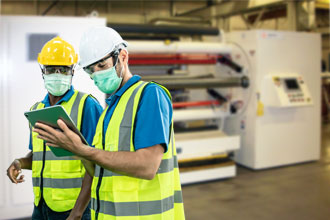by Joe Connelly , Product Manager - Winding and Slitting

In a year that has caused most of us to cancel plans and carry on in very unnatural ways with great uncertainty, we have all been guided by two essential words – “be safe.” To persevere through this unprecedented pandemic, those words that, by definition, mean to be free from harm or risk encourage us to stay out of harm’s way and avoid illness. Living safely is something that we have, for the most part, taken for granted, until this year, where we have been constantly reminded to live our lives in a manner that keeps us safe.
This safety mantra is undoubtedly not a new concept to design, maintain, or operate web handling or converting equipment. Machine safety and safe working practices are by no means foreign to us. However, as our technology and processes evolve, so do the requirements that appear in our national safety standards as they are updated to meet these conditions. Keeping up with the latest national standards is important not only for those planning new purchases but also for owners of existing equipment to better understand what is considered safe practices today and what might be referenced by law professionals in an injury case.
Recently there have been two updated national safety standards issued that apply to the equipment used for web handling. The Plastics Industry Association (PLASTICS), in cooperation with ANSI, issued ANSI / PLASTICS B151.5- 2020 Safety Requirements for Plastic Film and Sheet Winding and Unwinding Machinery. Given that the flexible packaging industry is the largest consumer of plastic film and sheet in the world, this standard pertains to a vast majority of the converting equipment in operation. ANSI also issued a very comprehensive update to its B11.19-2019 Performance Requirements for Risk Reduction Measures: Safeguarding and other Means of Reducing Risk, which applies broadly to the equipment used in our industry. This standard outlines the responsibilities of users or builders of equipment and integrators, modifiers, and rebuilders to mitigate hazards within each group’s scope of work activities.
A common topic in both documents is risk assessment, which is not a new concept, but many new safety guidelines emphasize it. There are third-party organizations with expertise in these procedures that can provide assistance and make recommendations on improving the safety of your equipment.
I mention these two specific documents, but there are many additional ANSI, ISO, and EN standards that pertain to subsets of machines. Given that these take precedence over the more generic standards, they should be followed if they exist for your specific industry or application.
For a list of standards specific to the plastics processing industry, visit https://www.plasticsindustry.org/standards.
To review which of the many ANSI B11 safety standards might apply to you, visit https://www.b11standards.org/standards.
Manufacturers of industrial safety devices and machinery control systems are continually developing new products in response to the updated safety requirements. They can be excellent resources for which devices or systems to consider and ways to apply them to ensure that your equipment meets today’s safety standards. For it is way better to be safe ― by working with the latest guidelines, understanding the risk assessment process, and putting the necessary risk reduction measures in place than to be sorry.
Please contact us If you would like to learn more.